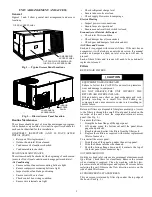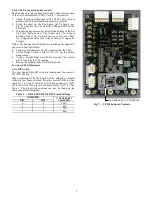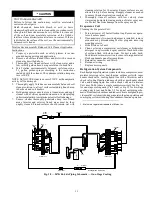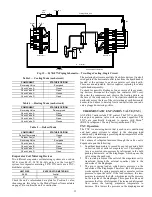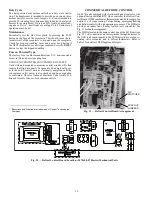
7
TROUBLESHOOTING THE ECM MOTOR
Axion™ Fan motors are designed with several built-in protec
-
tions included in the motor software. If the motor detects a fault
it will safely shut down. For temperature related faults the motor
requires a line voltage reset to continue operation. For all others,
the motor will resume operation automatically as soon as the
fault condition is cleared. See Table 2 for a complete list.
Table 2 — Fault Condition/Reset Trigger
Troubleshooting the motor requires a voltmeter.
1. Disconnect main power to the unit.
2. Disconnect motor plug in supply section of the unit.
3. Restore main unit power.
4. Check for proper line voltage at motor power leads Black
(PL1-1), Yellow (PL1-2), and Blue (PL-3). Blue is only
present on 3-phase motors. See the following table.
5. Disconnect main power.
6. Reconnect motor plug in supply section of unit.
7. Restore main power.
8. Check for proper motor control voltage signal of 9.7Vdc
to 10.3Vdc at IFM-1 and IFM-3 on Unit Control Board
(UCB). See Fig. 9.
9. Using a jumper wire from unit control terminals R to G,
engage motor operation.
10. Verify control signal from user speed selection switch by
placing voltmeter taps in provided terminals marked Vdc.
Signal should be between 3.8Vdc and 10.3Vdc.
11. If the motor does not start and run, remove the fan assem
-
bly and replace the motor with one having the same part
number. Do not substitute with an alternate design motor
as the voltage/speed programming will not be the same as
that on an original factory motor.
Removing the Motor and Fan Assembly
NOTE: Due to press fit design of composite Rotor on Motor, it is
highly recommended that any time a motor is replaced the fan
rotor is replaced as well. The rest of the assembly may be reused.
See Fig. 10.
1. Unplug motor harness from control box harness and cut
wire tie at the fan deck.
2. Unplug connectors from stator temperature limit switch.
3. Remove two screws at front of stator on fan deck.
4. Slide fan assembly forward a couple of inches to clear rear
brackets and lift assembly out.
Fig. 9 — Supply Fan Control Wiring Diagram
Fig. 10 — Fan Assembly Removal
Disassembling Motor and Fan Assembly
See Fig. 11.
1. Remove six screws from retaining rings in the top of the
fan rotor.
2. Remove rotor from motor.
3. Remove four screws connecting motor to stator flange.
4. Remove stator from motor.
Fault
Condition
Reset
Trigger
Description
Phase Failure
Automatic
One phase is missing or imbalanced. In
this case the motor will come to a stop
and then automatically restart when all
phases are present.
Locked/ Blocked
Rotor
Automatic
The rotor is blocked. Once the locking
mechanism has been removed, the
motor will automatically restart.
Motor Over
Heated
Manual
The motor will stop in the event the
motor over heats. In this case there has
to be a manual restart.
Power Module
Over Heated
Manual
The motor will stop in the event the
electronics over heat. In this case there
has to be a manual restart.
Line under-
voltage
Automatic
Once the line voltage returns within
permitted operating range, the fan will
automatically restart.
Communication
Error
Automatic
Internal communication error of the
fan’s electronics. The fan will restart
automatically, if error is cleared.
547KUnit Voltage
Motor Voltage
Min-Max Volts
208/230
230
190-250
460
230
210-250
575
460
420-500
4
2
1
3
Содержание 547K
Страница 94: ...94 APPENDIX D WIRING DIAGRAMS Fig I 547K 04 06 Power Wiring Diagram 208 230 1 60 ...
Страница 95: ...95 APPENDIX D WIRING DIAGRAMS Fig J 547K 04 07 Power Wiring Diagram 208 230 3 60 ...
Страница 96: ...96 APPENDIX D WIRING DIAGRAMS Fig K 5047K 04 07 Power Wiring Diagram 460 575 3 60 ...



